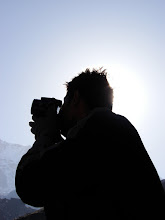Wednesday, September 9, 2009
Altutude Sickness & Acclimatization
The briefing will contain a detailed section on altitude sickness and other medical issues ...
A general mountain rule is that you should not generally ascend more than 300 metres per day and for each 1000 metres that you do ascend you should take a rest day.
In climbing terminology, mountain altitudes are divided into three zones ... high, very high and extreme. As you can see below, this climb involves extreme altitudes and is therefore a serious and potentially dangerous undertaking ...
High altitude 2400m to 4200m 2400m to 4200m
Very high altitude 4200m to 5400m
Extreme altitude above 5400m
AMS : Acute Mountain Sickness : During the trek it is likely that more than 75% of climbers will experience at least some form of mild altitude sickness. This is caused by the failure of the body to adapt quickly enough to the reduced level of oxygen in the air at an increased altitude. There are many different symptoms but the most common are headaches, light headedness, nausea, loss of appetite, tingling in the extremities (toes, fingers) and a mild swelling of the face, ankles and fingers. These symptoms in a mild form are not serious and will normally disappear within 48 hours, the result of poor circulation or a small leakages of fluids within the body.
HAPE : High Altitude Pulmonary Oedema : "water in the lungs" : This more serious sickness has very clear symptoms ... breathlessness at rest, very high pulse, crackling sound in the chest leading to coughing of fluid (sputum). This condition is rapidly fatal unless the casualty experiences immediate descent. There are no drugs to cure and no possibility of re-ascent on this trip.
HACE : High Altitude Cerebral Oedema : "swelling in the brain" : Again there are clear symptoms ... a COMBINATION of two or more of the following : Very severe headache, severe loss of balance, mental confusion, repeated nausea. This condition is rapidly fatal unless the casualty experiences immediate descent. There are no drugs to cure and no possibility of re-ascent on this trip.
Climbers should not be scared by all this talk, but it is essential that they understand that if they push on or stay at same altitude with HAPE or HACE they will die. People do. Even serious cases of altitude sickness can only be treated by immediate descent. Our Western leaders and local guides are all experienced in dealing with the problems of altitude. It may be neccessary for you to descend to a lower altitude until you recover or even to abandon the climb in the interests of safety. The decision of the Western leader or the Senior guide in such situations will be final.
There are six main factors that affect the incidence and severity of altitude illness ...
1 Rate of ascent
2 Altitude attained
3 Length of exposure
4 Level of exertion
5 Hydration and diet
6 Inherent physiological susceptibility
The following three steps are a guide to achieving acclimatisation:
Water : A fluid intake of 4 - 5 litres per day is recommended. Fluid intake improves circulation and most other bodily functions, but does not increase fluid leakage from the body. Thirst should not be an indicator of proper fluid intake, if your urine is clear then you are drinking enough.
Slow Walk : Pace is a critical factor on all routes. Unless there is a very steep uphill section your breathing rate should be the same as if you were walking down the street. If you cannot hold a conversation you are walking too fast. Breathing through the nose for the first 2 days of the climb will limit the pace. Walk "softly" allowing your knees to gently cushion each pace. "Pole pole" < go slowly > is the phrase that will echo around your head as it is repeated to you by the guides.
Walk high sleep low : If you have enough energy and are not feeling the affects of altitude, then you mights take an afternoon stroll further up the mountain before descending to sleep. Almost all routes offer an extra day for acclimatisation. Taking this day increases your chances of getting to the top by 30% and increases you chances of actually getting some enjoyment out of the experience by much more than that. We do not offer climbs which do not include this extra day.
Subscribe to:
Posts (Atom)
